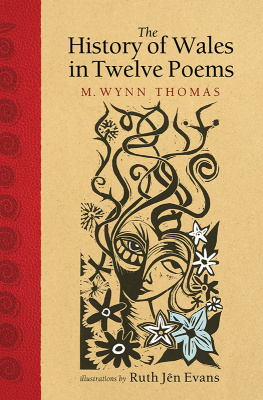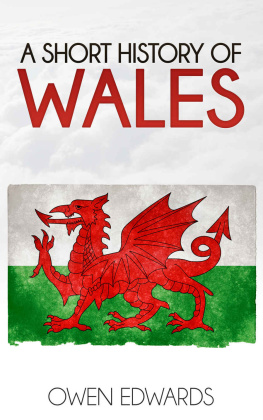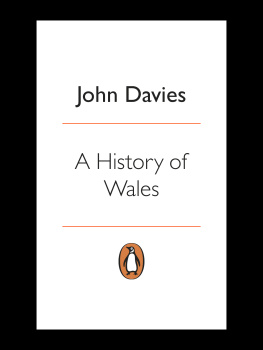Wales since 1939
Martin Johnes
Copyright Martin Johnes 2012
The right of Martin Johnes to be identified as the author of this work has been
asserted by him in accordance with the Copyright, Designs and Patents Act 1988.
Published by Manchester University Press
Oxford Road, Manchester M13 9NR, UK
and Room 400, 175 Fifth Avenue, New York, NY 10010, USA
www.manchesteruniversitypress.co.uk
The publisher acknowledges the financial support of the Welsh Books Council.
Distributed in the United States exclusively by
Palgrave Macmillan, 175 Fifth Avenue, New York,
NY 10010, USA
Distributed in Canada exclusively by
UBC Press, University of British Columbia, 2029 West Mall,
Vancouver, BC, Canada V6T 1Z2
British Library Cataloguing-in-Publication Data
A catalogue record for this book is available from the British Library
Library of Congress Cataloging-in-Publication Data applied for
ISBN 978 0 7190 86663 hardback
ISBN 978 0 7190 86670 paperback
First published 2012
The publisher has no responsibility for the persistence or accuracy of URLs for any external or third-party internet websites referred to in this book, and does not guarantee that any content on such websites is, or will remain, accurate or appropriate.
Typeset in Perpetua by R. J. Footring Ltd
Printed in Great Britain
by TJ International Ltd, Padstow
This book is dedicated to my daughters, Bethan and Anwen,
in the hope that they will grow up to realize that Wales matters
but that there are other things that matter more.
Contents
Figures and tables
Figures
Tables
Acknowledgements
Thanks are due to the following people for their help with sources, leads and ideas: Duncan Bush, Gillian Clarke, John Conibear, Lewis Davies, Andrew Edwards, Rebecca Edwards, Neil Evans, Neil Fleming, Gwenno Francon, Roger Granelli, Ralph Griffiths, Richard Johnes, Bill Jones, Sarah L. Jones, Daryl Leeworthy, James Mabbett, Mass Observation, George McKechnie, Christopher Meredith, Louise Miskell, Steffan Morgan, Adam Mosley, John Osmond, Rachel Pick, Elain Price, Steve Smith, Wyn Thomas, Peter Wakelin, Paul Ward, Chris Williams, Daniel Williams and Nick Woodward. I am especially grateful to Huw Bowen, Peter Stead and Gareth Williams, who read the whole text, and to Ralph Footring, who drew the maps and was a thorough and eagle-eyed copy-editor. The book could not have been started let alone finished without the remarkable Heather Moyes, who keeps my life and me on track.
Further resources
For full details of the sources used, links to websites referenced, and for further reading, resources and notes please visit www.hanescymru.com .
Note on the use of place-names
Where places have different official names in English and Welsh, the English form is used (thus Caerphilly rather than Caerffili). Where Anglicized place-names have been dropped at some point since 1939, the modern Welsh form is used regardless of the period being discussed (thus Llanelli rather than Llanelly). The Valleys refers to the industrial valleys that stretch from east Carmarthenshire to west Monmouthshire (see map overleaf). This area is loosely equivalent to the south Wales coalfield and, despite never being officially defined, the term was widely used. Rural Wales is generally used in the text to signify the 197496 counties of Dyfed, Gwynedd and Powys (see map overleaf) but might also include the large rural tracts in parts of Clwyd and Glamorgan. Where Wales is referred to in the text it includes the county of Monmouth, whose legal status as part of Wales was a little ambiguous before 1974 (hence the contemporary term, not used here, Wales and Monmouthshire), even though it was a Welsh county for all political and administrative purposes. The counties of Wales were reorganized in 1974 and 1996 and the book uses whichever name was in existence in the period being referred to. Y Fro Gymraeg refers to the Welsh-speaking heartland. The precise area denoted by the term diminished over the period but it is generally taken to mean those parts of the rural west and north where Welsh was the dominant language.
The counties of Wales: above, pre-1974; left, 197496.
Abbreviations used in endnotes
CDH | Caernarvon and Denbigh Herald and North Wales Observer |
CJ | Carmarthen Journal |
CW | Contemporary Wales |
DWHS-1 | John Williams, Digest of Welsh Historical Statistics, vol. 1 (Cardiff, 1985) |
DWHS-2 | John Williams, Digest of Welsh Historical Statistics, vol. 2 (Cardiff, 1985) |
DWHS-3 | John Williams, Digest of Welsh Historical Statistics, 197496 (Cardiff, 1998) |
DWS | Digest of Welsh Statistics |
HC Deb | House of Commons Debates (Hansard) |
LDP | (Liverpool) Daily Post |
NA | National Archives |
NAW | National Assembly for Wales |
NLW | National Library of Wales |
Pl | Planet |
SWE | South Wales Echo |
SWEP | South Wales Evening Post |
WAG | Welsh Assembly Government |
WHR | Welsh History Review |
WL | Wrexham Leader |
WM | Western Mail |
Introduction
CAPT JOHN ROBERTS: All this play-acting about Wales doesnt matter, boy. Wales is just another country like any other.
MORGAN (quietly): It isnt to me, Pa. Ive made it my world.
After the Funeral, in Alun Owen, Three TV Plays (1960), 103
ANYONE CROSSING THE BORDER from England into mid Wales during the 1930s or 1940s would probably not have noticed that they had entered a different country. There were no signs offering a welcome to Wales. Before they had reached Wales they might have already travelled through villages with names like Craigllwyn or Llanyblodwell or passed a chapel in Oswestry where services were held in Welsh. Yet, when one traveller asked a road sweeper where the border was, he was told that the front wheels of his car were in Wales and the back ones in England. There was no marker but the sweeper knew all the same. Moreover, he was offended when the traveller asked if he was Welsh because of his sing-song accent.the nation: rural and beautiful but at odds with the modern world, a place connected to England but different.









